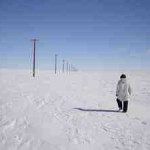

Scientists at the Department of Energy’s Oak Ridge National Laboratory are planning a large-scale, long-term ecosystem experiment to test the effects of global warming on the icy layers of arctic permafrost.
While ORNL researchers have conducted extensive studies on the impact of climate change in temperate regions like East Tennessee, less is known about the impact global warming could have on arctic regions.
“We’re beginning to take these lessons learned and start applying them to sensitive and globally important ecosystems, such as the arctic,” said Stan Wullschleger of the Environmental Sciences Division. “The arctic regions are important to the topic of global warming because of the large land area they occupy around the world and the layer of permanently frozen soil, known as permafrost.”
Wullschleger and a team of architects, engineers and biologists from ORNL and other national laboratories design, simulate using computers and then field test large-scale manipulative experiments that purposely warm a test area in order to evaluate ecosystem response to projected climate conditions.
“Evidence is emerging that the arctic is experiencing a greater degree of warming than the rest of the globe,” Wullschleger said. “There is growing concern that this warming is already affecting a wide range of physical and ecological processes in the arctic, including permafrost degradation. Manipulative experiments will help us study these processes and their consequences in great detail.”
In the arctic study for the Department of Energy’s Office of Science, researchers seek to develop specially designed above-and below-ground warming technologies to heat multiple plots of land about 20 meters in diameter. ORNL researchers hope to eventually have replicated plots with treatments that include heating in combination with elevated carbon dioxide.
“The way we design and arrange the above- and below-ground heaters will allow us to warm the air and soil in a manner representing future conditions and then study the consequences of that warming,” Wullschleger said.
Wullschleger and others working on the project hope to discover whether carbon stored in permafrost will be released as the soil warms. This could have major consequences for climate.
Before work can begin, a team of engineers and architects must adapt the heater technology that has been used on the Oak Ridge Reservation to study temperate region plants like maple and oak trees to Alaska’s harsh winters and icy soil.
“We’re developing a prototype because we haven’t tested the equipment under arctic conditions before. In parts of Alaska, temperatures will drop to minus-40 degrees Fahrenheit,” Wullschleger said.
Results from the prototype tests, modeling simulations, and other scientific analyses will be used to determine the location of the long-term ecosystem experiment.
Wullschleger is collaborating with the U.S. Army Cold Regions Research and Engineering Laboratory in Fairbanks and the Barrow Arctic Science Consortium in Barrow, Alaska. The team plans to hold workshops in collaboration with the International Arctic Research Center at the University of Alaska to get the science community involved in details of the planned experiment.
“That will be a major undertaking, and it will involve the support of the larger scientific community. We want to ensure, right from the beginning, that others are able to contribute to the development of this grand activity,” Wullschleger said.
ORNL is managed by UT-Battelle for the Department of Energy’s Office of Science.
Source:Oak Ridge National Laboratory.



